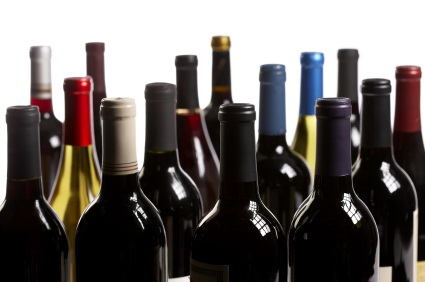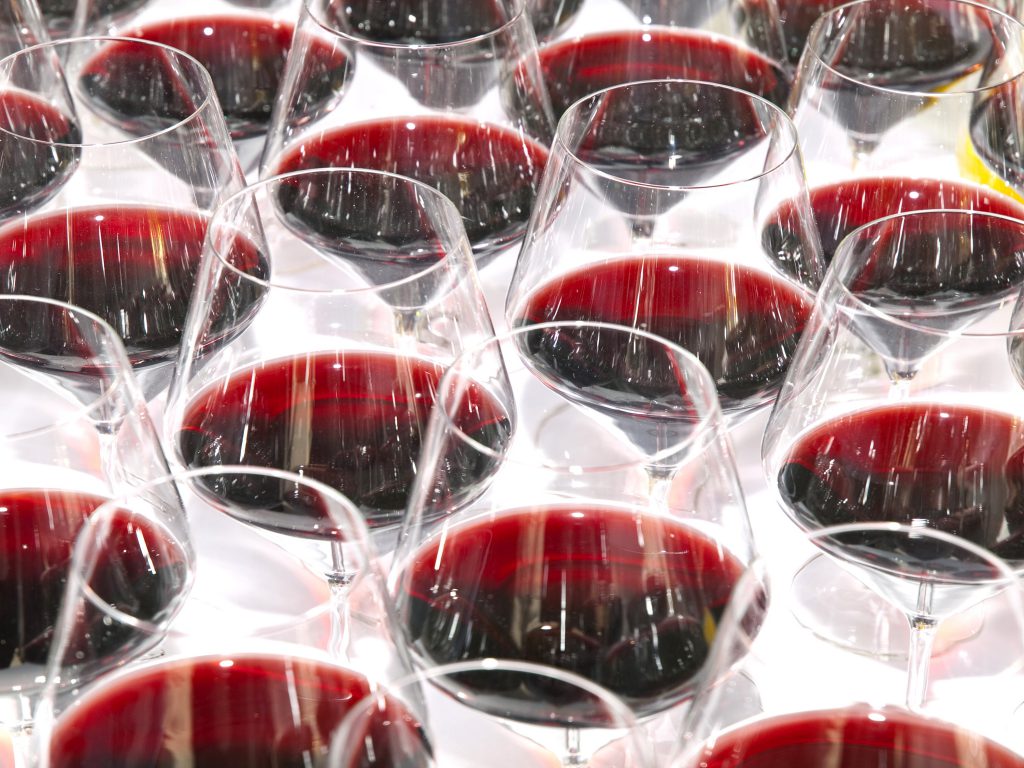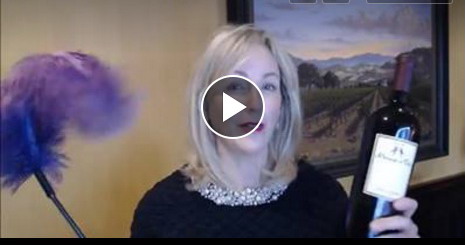In our latest Facebook Live Video chat, we chat about the robust red wine Zinfandel.
What makes it different from other red wines? How is it related to the Italian red wine Primitivo?
What foods pair best with Zinfandel? What’s the group Zinfandel Advocates and Producers (ZAP) all about, and International Zinfandel Day on November 19?
You can click on the arrow above to play the video.

Zinfandel is a vitis vinifera red wine grape that produces deep robust wines, most famously from California.
You’ll find my most recent Zinfandel reviews and ratings here.
Surprising Facts about Zinfandel:
1. Zinfandel’s high sugar content means it can be fermented into highly alcoholic wines sometimes in excess of 15%. Zinfandel is generally early ripening as compared to other grapes and grows in very tight bunches.
These tight bunches are prone to bunch rot and uneven ripening. Zinfandel grows best in warm climates but there is cool climate Zinfandel.
2. The origin of Zinfandel seems to be Croatia where Zinfandel was the basis of winemaking in the 19th century. DNA fingerprinting reveals Zinfandel is genetically linked to the Croatian grapes Crljenak Kastelanski and Tribidrag.
3. Primitivo is grown in the Puglia region of Italy and estimated to be that country’s 12th most planted varietal. Historically, Primitivo was fermented and shipped north to Tuscany and Piedmont to be blended with regional wines to add depth.
Today, Primitivo is made in a rustic style with high alcohol up to 16% and aged in American oak to give Primitivo its American Zinfandel style.
4. Zinfandel then made its way across the Mediterranean Sea to Puglia, Italy where Zinfandel is known as Primitivo. Zinfandel’s arrival in the United States may have been on Long Island, New York.
Ridge Geyserville Zinfandel
Alexander Valley, Sonoma County, California, United States
George Gibbs, a horticulturist, received grapes for planting from Austrian controlled Croatia between 1820-1829. At that time Zinfandel was treated as a table grape.
The 1850’s California Gold Rush brought Zinfandel to California as a table grape. William Robert Prince and fellow horticulturalists such as Frederick W. Macondray joined the Gold Rush and it was during that time they noted Zinfandel’s ability to dry into beautiful raisins.
Joseph W. Osborne was the first to make wine from Zinfandel with grapes he received from Macondray. He planted them at his Oak Knoll vineyard in the North Napa region. His wine was praised and
Zinfandel took off. By the late 19th century it was the most planted varietal in California.
5. The Great Depression and Prohibition during the 1930’s seriously stunted the growth of the Zinfandel wine industry. As the Depression and Prohibition ended there was a serious lack of quality Zinfandel grapes and this left Zinfandel all but forgotten.
In 1972, a British wine writer wrote about “a fascinating California grape.” American writers began singing the praises of Zinfandel calling it “a California original.”
Today Zinfandel is the third most planted grape in California behind Chardonnay and Cabernet Sauvignon.
Ravenswood Vintners Blend Old Vine Zinfandel
California, United States
Zinfandel characteristics vary depending on where it is grown and ripeness of grapes at harvest. Warm climate Zinfandel displays deep colour, juicy texture, blackberry, anise and pepper. Raspberry and strawberry in cooler climates.
Exceptional Zinfandel comes out of Napa and Sonoma, Russian River Valley, Paso Robles, Amador and Santa Clara Valley in California.
Other counties growing small amounts of Zinfandel are: South Africa, Australia, Mexico and Croatia.
Food pairing: BBQ meats or hearty meat meals, lasagne, cannelloni, spaghetti Bolognaise, aged cheddar, Asiago
When you join our wine community as a Paid Member, you’ll get access to all of my Zinfandel wine reviews, which are updated weekly.
ZINZEN, ZINZEST, ZINFUL: The licence plates in the parking lot warn me that this is no tweedy wine tasting. Closer to the wharves, a line of three thousand people, thick as an anaconda, snakes its way along San Francisco’s waterfront.
Behind them soars the Golden Gate Bridge; Alcatraz Island sits brooding in the distance; and the glinting bay is dotted with tiny tissue sails. But no one’s admiring the postcard view: all eyes are fixed on the warehouse’s paint-peeled doors, waiting for them to open on the Zinfandel Advocates and Producers tasting, the world’s largest single-varietal wine event according to the Guinness Book of World Records.
Carnivor Zinfandel
California, United States
As the doors open, zinophiles surge forward into two football-field-sized buildings to taste the barrel samples. Vital attributes for this tasting are Teflon taste buds, sharp elbows and a talent for eavesdropping: every now and then, a buzz sweeps through the crowd, with feverish whispers about this or that new zin.
The resulting rush in that direction is not unlike the stampede that ensues when K-Mart announces a Blue Light Special in aisle six. Many drinkers here are on a mission to find the Next Big Thing—before it’s priced that way.
The tables are lined up alphabetically by the 255 wineries—many of them family-run operations that produce only a few hundred cases a year. Boutique wineries include D-Cubed, Tria, Brown Estate Vineyards, Kunin, Tarius, Outpost and S. E. Chase Family Cellars.
Seghesio Zinfandel
Sonoma County, California, United States
They’re pouring 510 different zinfandels for sampling by some 9,200 attendees. That’s up 50 per cent from last year, and exponentially up from the first tasting twenty years ago—which drew only 22 wineries and 100 participants.
The thickest crowd presses in around the “R” section: Ridge, Rosenblum, Ravenswood, Rafanelli and Rochioli are some of the top-rated zin wine makers. Ridge is often considered the original zinfandel producer: winemaker Paul Draper was an early exponent of the wine in the late 1960s.
When he accepted Decanter magazine’s Man of the Year 2000 award, Draper said: “I’d like to thank zinfandel, without which I’m sure nobody would know who I am.”
Zinfandel has been called the world’s most misunderstood grape. Until recently, many wine enthusiasts thought that the red grape could only produce a pink syrup, and didn’t realize that it was also capable of creating dense, opulent, structured red wine.
With 46,000 acres under vine, zinfandel now ranks second only to cabernet among red grapes in California. But even though zin has been a popular domestic wine for years, is not native to California.
Zin’s story is as American as the rags-to-riches characters in an E.L. Doctorow novel. Like the thousands of men and women who left their homelands and arrived at Ellis Island, the zinfandel vine is believed to have travelled in with early immigrant winemakers.
Frei Brothers Winery Reserve Zinfandel
Dry Creek Valley, Sonoma County, California, United States
A bastard child without old money or known European lineage, zinfandel wasn’t even counted among the noble grapes such as chardonnay or cabernet. It had to work its way from the ground up.
Its first test was Prohibition, and it passed Horatio-Alger style. Some growers sold zinfandel “must,” the dried, compressed grape material in brick form to Italian families—warning that the brick should never come into contact with yeast, or wine might inadvertently result. Of course, most of those buying the bricks were home winemakers.
Zinfandel’s second saving grace, and its curse, was white zinfandel. In the 1970s, Bob Trinchero of Sutter Home decided to bottle and sell the clear run-off juice from pressing red zin. Customers complained that the resulting wine was too dry, so he sweetened it—and then could barely keep up with demand. Other wineries jumped on the bandwagon, but Sutter Home still leads the market: in 1999, it produced four of the twenty million cases of white zin sold in the U.S.
Big House Cardinal Zin Zinfandel
California, United States
Despite its popularity, though, white zin is still viewed as “industrial pre-mix” and “accessible”—the descriptive kiss of death among wine snobs. Some drinkers think of white zin as a transitional wine that bridges the taste gap between juice and soda pop, and dry table wines—including red zinfandel. According to Sutter’s research, 60 per cent of drinkers stay with white zin, 20 per cent go on to other styles of wine and a disillusioned 20 per cent stops drinking wine altogether.
It was the rise of white zin that, in 1991, motivated a small group of aficionados to establish Zinfandel Advocates and Producers (ZAP), an organization dedicated to restoring red zinfandel to its status as America’s heritage grape.
ZAP’s informal motto became: “The first obligation of wine is to be red.” Today, it’s one of the largest consumer-based wine advocacy groups in the world, with some 6,000 purple-card-carrying members—a quarter of whom live outside California. (A support group for a grape—it could only happen in America. What might our Canadian equivalent be: Baco Buddies?)
Even red zinfandel, though, is not hailed for its elegance: it’s Caliban to burgundy’s Ariel. With tooth-stripping alcohol levels of 17 per cent, many zins embody Ravenswood’s motto: Nullum vinum flaccidum (No wimpy wines). The dense fruit and opulent texture of zin make syrup seem runny by comparison. As one vintner observed, aging zin in French oak is like putting perfume on John Wayne.
The names also go for weight over grace: The Monster, Wild Thing, Monga Zin and Blockheadia. Other producers take a comic approach with names such as Victor Hugo, Commander Zinskey, Zin Man and Zebra Zin. The front label on Bonny Doon winery’s Cardinal Zin label shows a cardinal spitting zinfandel; the back label describes the wine in terms of the “seven deadly zins,” and suggests pairing the wine with game and other wild animals—including sloth.

But whatever the experts’ disdain for the pink stuff, people buy it and its popularity has helped to save old vineyards from being ripped up and replanted with the more fashionable chardonnay, cabernet and merlot. Part of the vine’s success is that it seems to crop faster than ragweed: yields of ten to twelve tons per acre aren’t uncommon.
Cabernet, by contrast, yields only five to eight tons per acre. Zinfandel ripens early, albeit unevenly, and thrives even in hot sites—though it requires rigorous pruning, dry farming and coddling to get the low yields that produce more concentrated wine.
Gnarly Head Old Vine Zin Zinfandel
Lodi, California, United States
Low-yield zinfandel gives one of the purest expressions of terroir—the reason that producers of fine wine designate the vineyard on the label. Rosenblum, for example, produces seventeen different zins, some in batches of only 75 cases. In fact, the single-vineyard system resembles Burgundy’s small lots rather than Bordeaux’s larger blends. Red zinfandel favours small producers, while many large operations focus on white zin.
While zin is produced throughout California and in fifteen other states, its home is Sonoma’s Dry Creek Valley – where many Italian immigrants first planted the vines, and where the densest concentration of old vines can still be found.
Cantine Due Palme Primitivo
Salento, Puglia I.G.P., Italy
Napa may claim cabernet, and Carneros pinot noir, but fine zinfandel thrives in its proximity to the Pacific Ocean. Warm days raise grape sugars and cool nights preserve acidity, slowing maturation for greater intensity and complexity. Sonoma also has more microclimates than Napa, resulting in many more styles of zin.
The zinfandel vine is one of the few deliberately aged well past its prime – some are more than a century old. The gnarly, arthritic plants often appear in coffee-table books, in gauzy wine lifestyle ads, and on labels: many bottles at the ZAP tasting carry designations such as gnarly vines, knotty vines, century vines and ancient vines. Zin gets a longer lease on life than most vines.
Bordeaux vineyards, for example, have to be replanted every 25 to 45 years; but many in the industry agree that it takes fifty years for zin grapes to develop the deep flavours that make the superior wine. As the vines age, their fruit becomes increasingly concentrated and imparts character to the wine. But old vines don’t necessarily guarantee a better end product: some argue that it’s not age that matters, but superior planting sites.
Still, there are only a few hundred acres of old zin vines left in the world. James Wolpert, chair of the viticulture and oenology department at the University of California, Davis, established the Zinfandel Heritage Vineyard in the early 1990s as a vinous bridge to the past. He and colleagues planted six hundred vine cuttings, some more than a century old, in Oakville, California.
Many were gathered on “Old Zin Safaris,” on which the team drove around California in search of lost vines—often taking cuttings just ahead of the bulldozer. This Noah’s Ark of vines will be cultivated to help future winemakers, and to preserve the diversity of zinfandel against the flood of chocolate, vanilla and strawberry wines. (Read: homogenous versions of cabernet, chardonnay and merlot.)
It’s the increasing rarity of old vines, and consequently the diminishing yields, that are driving up the cost of good zin. The hardest thing to swallow about zinfandel today is often its price. Once considered more affordable than most reds, zin is now becoming more expensive as it gains greater acceptance. Few wines at the ZAP tasting were less than $30, and cult wines now easily cost more than $75.
Despite escalating prices—or perhaps because of them—the future of zin no longer seems in doubt. Last year, Canadian sales of red zin alone were 300,000 cases, up 26 per cent over the previous year, and 371 per cent since 1995. ZAP’s tireless lobbying efforts, bolstered by higher-quality wines and increased presence on restaurant lists, has led the California legislature to designate zinfandel as the state’s heritage wine.
But the most compelling evidence of zinfandel’s arrival as one of the world’s great wines is here on the floor. While taking copious notes may be good form in the Christie’s preview room or at a Bordeaux futures tasting, few are doing so at today’s event. But the tasters’ enjoyment is written all over their faces—and in their purple-stained smiles.
Apollonio Terragnolo Primitivo
Salento, Puglia I.G.T., Italy
Sidebar: recent DNA Discoveries
Where did zinfandel originate? Carol Meredith, professor of viticulture at University of California, Davis, initially thought zinfandel came from Italy — since the Italian grape primitivo and zinfandel are the same clone. However, primitivo only arrived in Italy recently, so it could not have been the ancestor of the zinfandel first planted in California 150 years ago. (But this didn’t stop Italian vintners from recognizing zinfandel’s success and trying to revitalize primitivo. In a reversal of traditional brand theft, several Old World vintners are now labelling their wines zinfandel to cash in on New World success.)
Meredith now believes zinfandel is closely related to a Croatian grape called plavac mali, grown on the Dalmatian coast of the former Yugoslavia. She has found all the “brothers, sisters and cousins” of zinfandel, but continues to search for the original clone. She’s now aided in this by recent advances in the science of vine DNA — akin to the human genetic techniques now used to identify criminals. And in addition to tracing the grape’s roots, Meredith is also making a genetic map of zinfandel – much like the larger map for the human genome.
Sidebar: Aging Zin
One of the marks of serious wine is that it ages well – up to several decades. However, fine red zinfandel hasn’t been made long enough to know its potential after cellaring for many years. The zinophiles whom I was able slow to a walking pace to chat with me at the tasting said they enjoyed their zins young and jammy — though this may have more to do with a bent toward instant gratification than a preference for young wine.
According to a Wine Spectator tasting of 37 zinfandels, varying in age from seven to ten years, the wines did not evolve to more complex character as do Bordeaux and Burgundies — but neither did they fall apart and become thin and insipid. They simply held their own.
If you’d like to read the 100+ comments, or make a comment yourself, visit:
https://www.facebook.com/natdecants/videos/10154477064559845
You’ll find the most recent live video wine tasting at the top of the timeline here:
We taste every Sunday evening at 6 pm eastern so add us to your calendar and grab a glass of wine.
Click on Follow, Like and Signup on the page above to get notified when we go live.
For more information on zinfandel, check out these articles:
Is Zinfandel the World’s Most Misunderstood Wine?
The Godfather of Zin: Tasting Zinfandel with Ravenswood Wines with Joel Peterson
Posted with permission from CTV



















